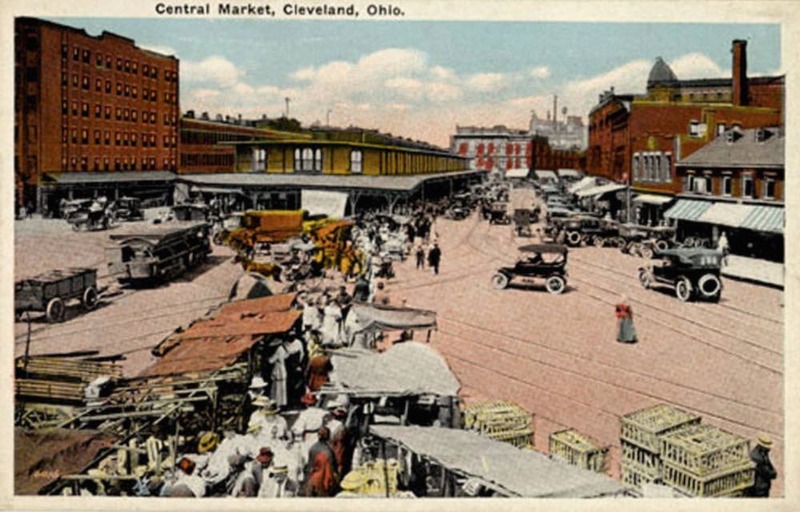Central Market

Cleveland's Central Market was a raucous place. Inside, dozens of languages careened around the cavernous facility like so many bouncing balls as haggling vendors and prospective customers shouted and gesticulated. Outside, horses, buggies, streetcars and (later) automobiles whinnied, rattled, screeched, roared, and honked.
For more than 100 years, beginning in 1856, the publicly owned Central Market near Ontario Street and Carnegie Avenue served a huge, mostly immigrant population living near or around the area. These people likely paid scant heed to the dim lighting, grimy walls, and constant noise because the market's 200+ stalls offered an unsurpassed assortment of meats, produce, and dairy products for generally reasonable prices.
Despite the constant busyness, Central Market was only one of several competing entities. From 1891 to 1936, the privately owned Sheriff Street Market at Bolivar Street and Huron Road just one block north competed with Central Market. Beginning in 1912, the magnificent West Market, situated a mile away at Lorain Avenue and West 25th Street, added to the fray.
By the middle of the 20th century, Sheriff Street Market had closed, the West Side Market was thriving, and Central Market was struggling. Central Market’s principal problem was a faltering infrastructure which raised costs for vendors. Newspaper articles lamented the poor lighting and grimy walls. Clutter abounded and safety concerns mounted. Inadequate parking (no lot and limited, on-street, meter-paid parking) was another headache. Bus service began to replace streetcars but the new bus lines didn’t stop as close to the market. Nonetheless, Central Market soldiered on. Local historian William Ganson Rose remarked that although the market was “antiquated and lacking in health and sanitary facilities, it continued to monopolize one of the busiest intersections in the city.”
Then came a fire. In December 1949, Central Market went up in flames, the result of a gas leak. This marked the end of the market’s residence at Ontario and Carnegie. However, within six months a new six-story Central Market opened (on March 24, 1950) at East 4th Street between Bolivar and Huron, near where the Rocket Mortgage FieldHouse now stands. Unfortunately, the same maintenance and custodial issues dogged the new facility and Cleveland city officials failed to provide the funds to overcome them. Produce stall owner Tony LoSchiavo observed, “We put a new ceiling in a few years ago, but there's some problems with that too. Some panels are out, and when it rains we have to put plastic tarp down. That looks like hell.”
From the 1950s, mass migration to the suburbs cut into the Central Market’s business. A few decades later came high inflation. By the 1980s, LoSchiavo's electricity bill approached $10,000 a month and steam heat bills were up as well. Most every vendor struggled to remain profitable. One poultry stall operator lamented, “This is Cleveland's forgotten market, and this is a quiet battle because probably few Clevelanders care how it ends—whether the market stays open or closes.”
At the same time, the West Side Market was growing in popularity. Unlike Central Market, the West Side Market remained proximate to residential neighborhoods and offered plenty of parking. It also was structurally sound and aesthetically pleasing, and it enjoyed steady funding from the city. According to one interviewee, the West Side Market “is the closest thing to Europe in Cleveland.”
By the 1990s it was time to pull the proverbial plug. Cleveland commissioners agreed to remove the New Central Market and build a massive sports complex on the land that had been occupied by both markets. In the markets’ place, Clevelanders now enjoy watching two of the country’s best baseball and basketball teams. And inside each complex, patrons somewhat grudgingly pay more than $15 for food and a drink. If the original and New Central Markets could have charged those prices, perhaps they’d still be around.
Images









